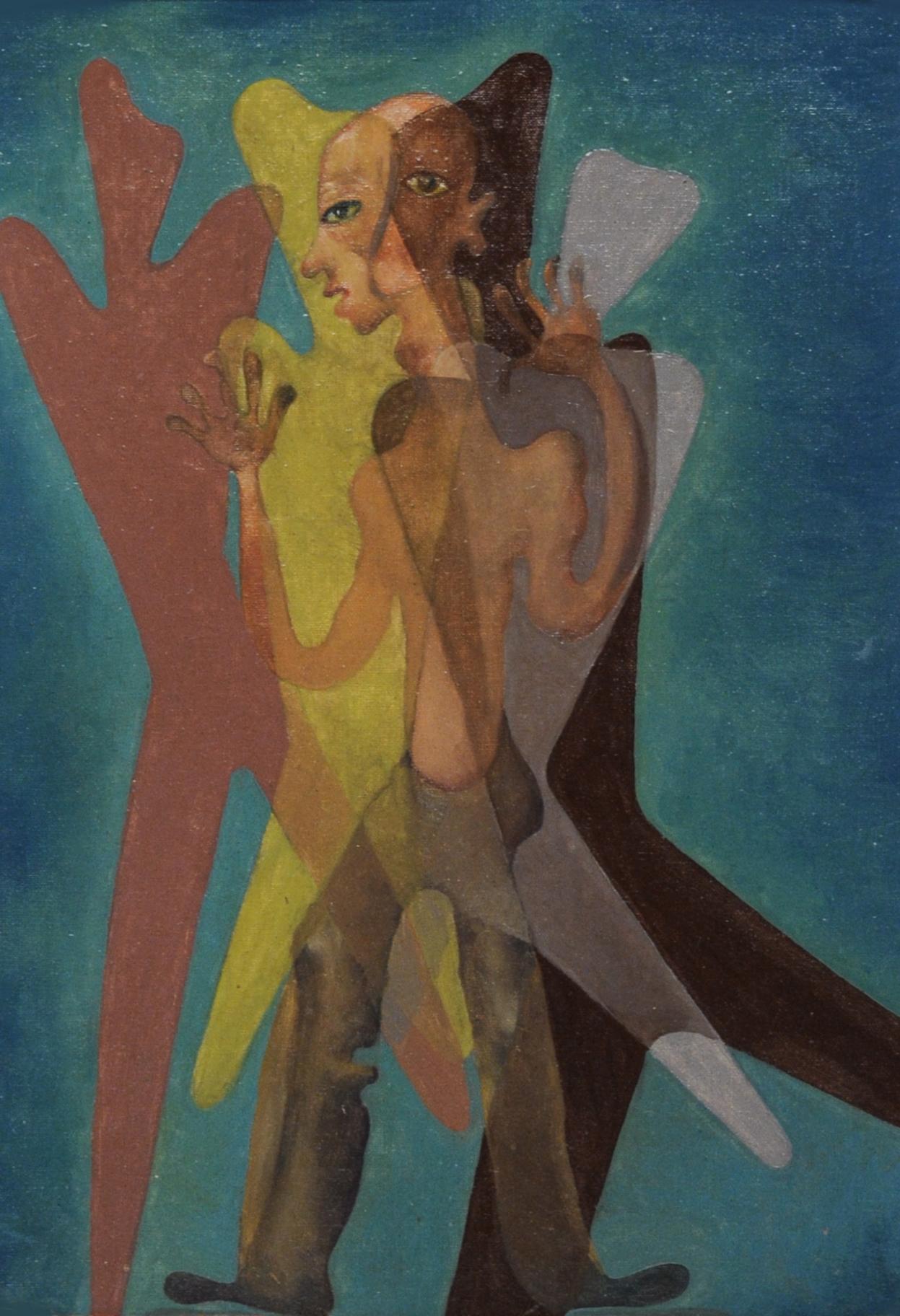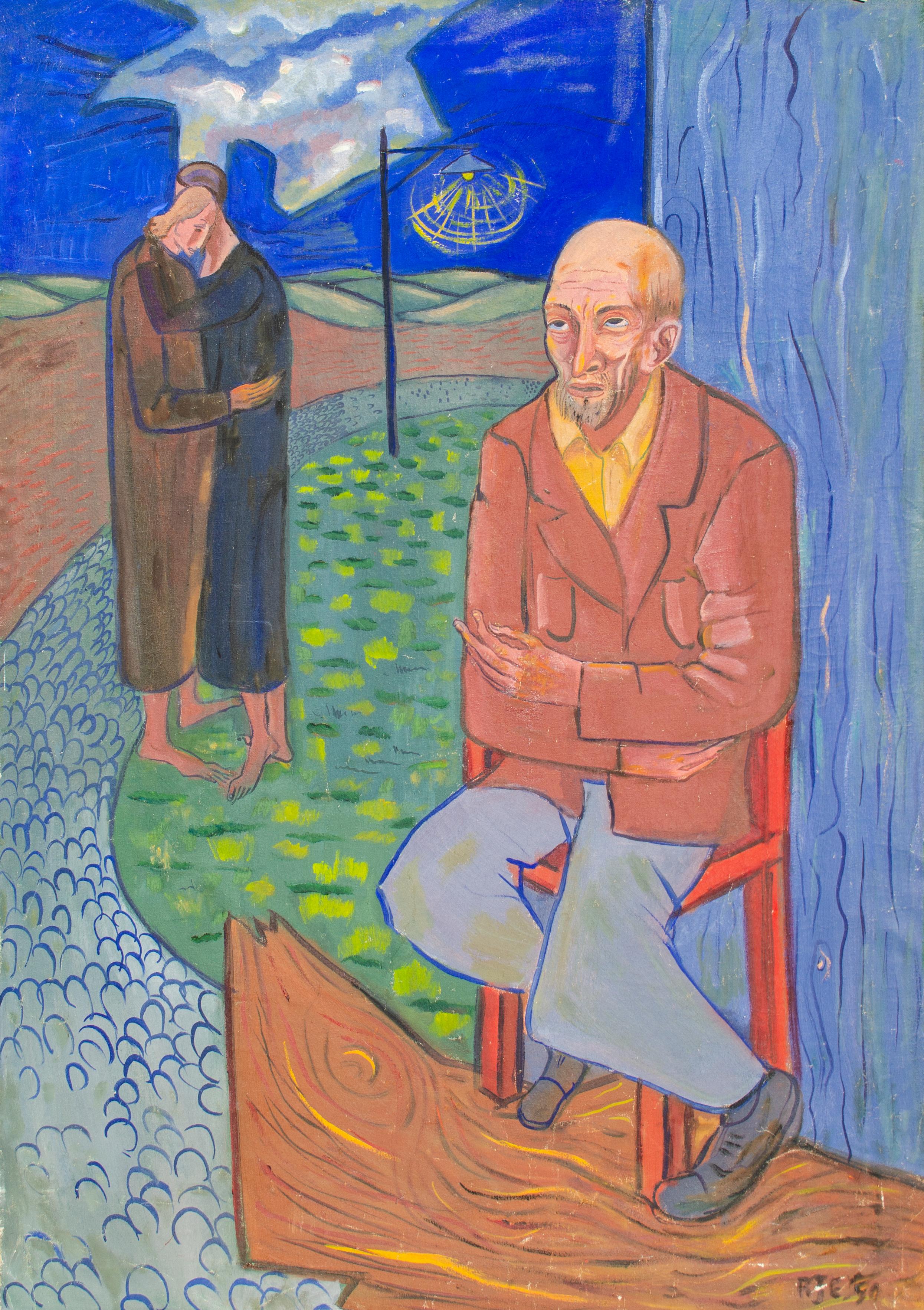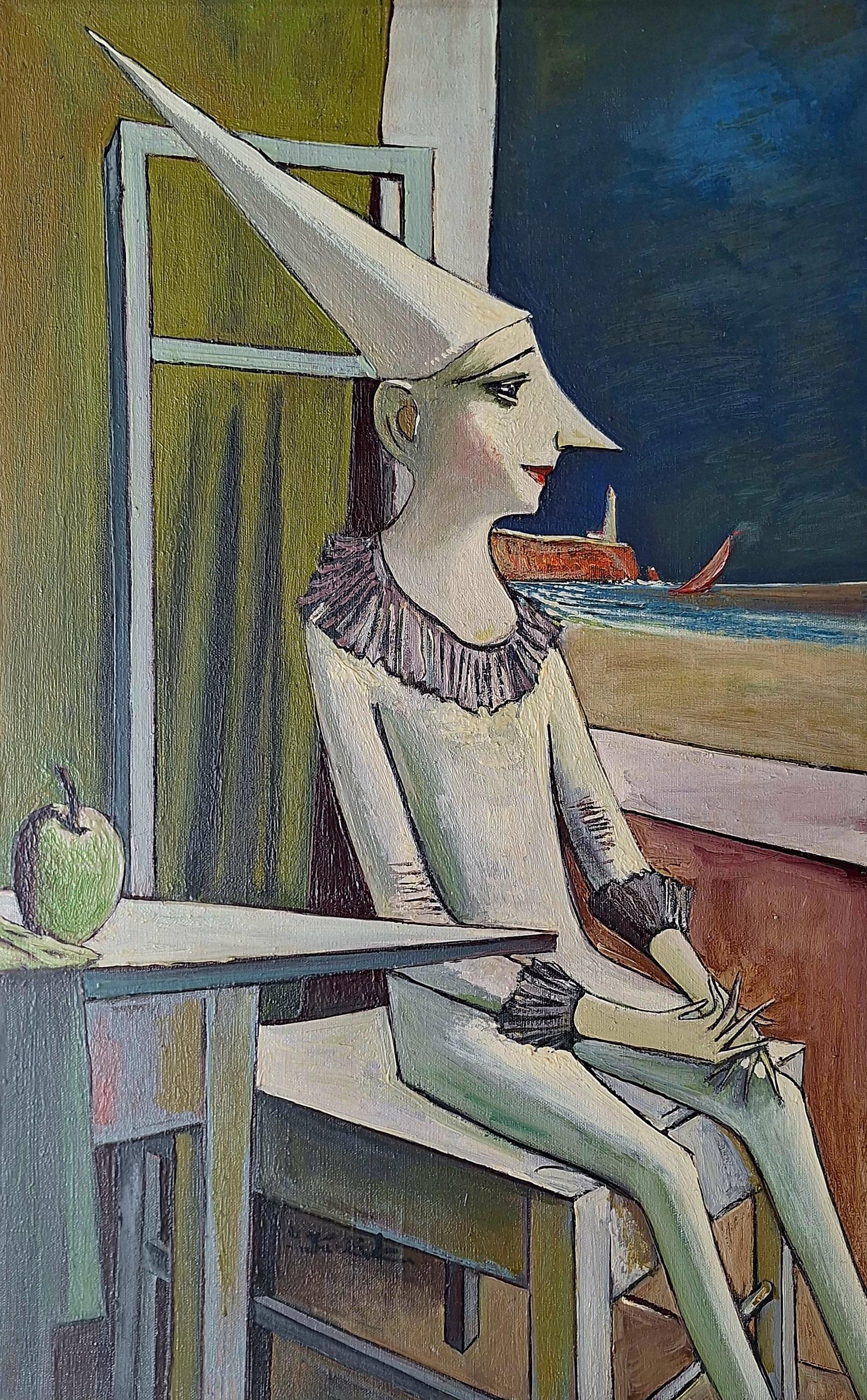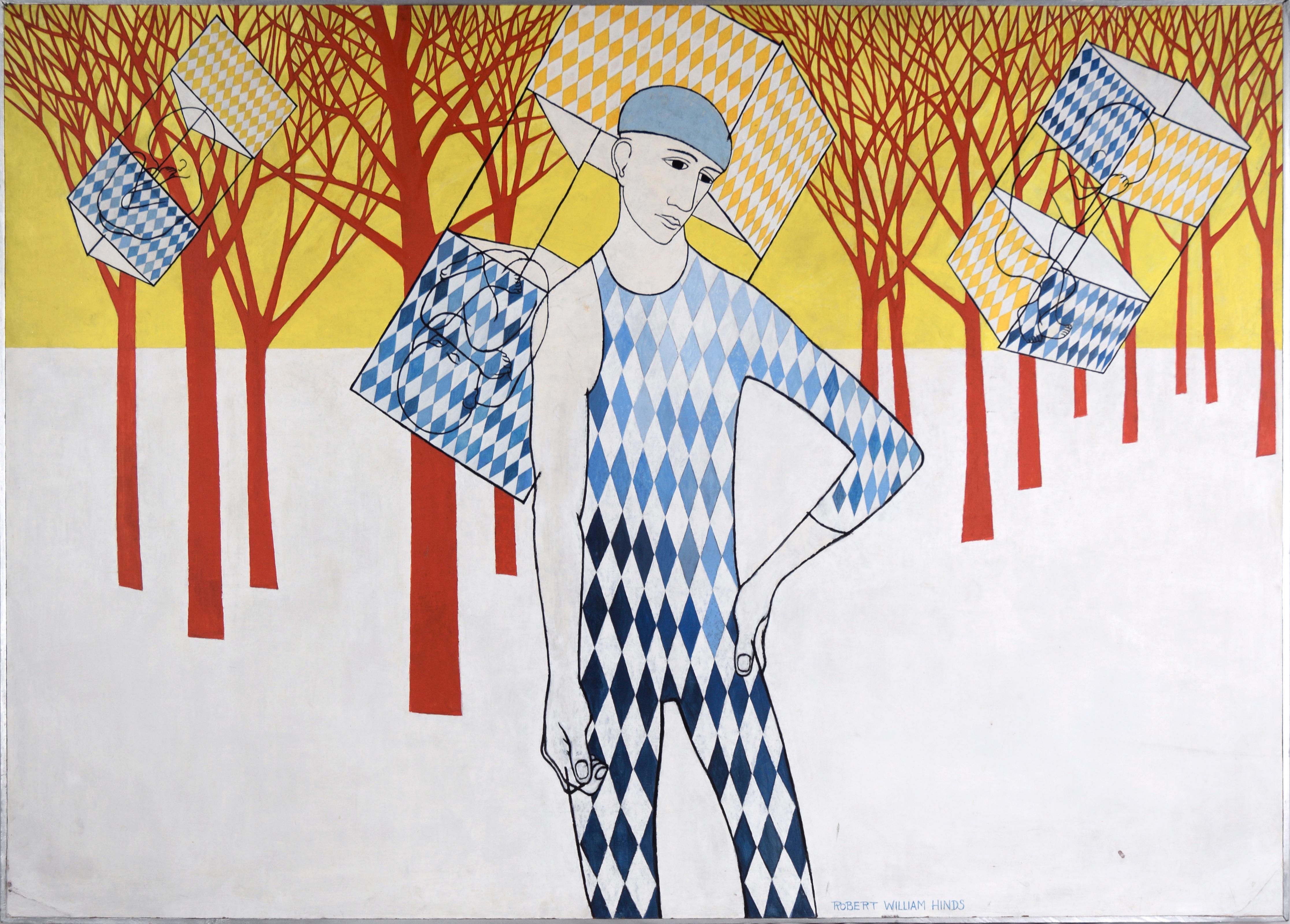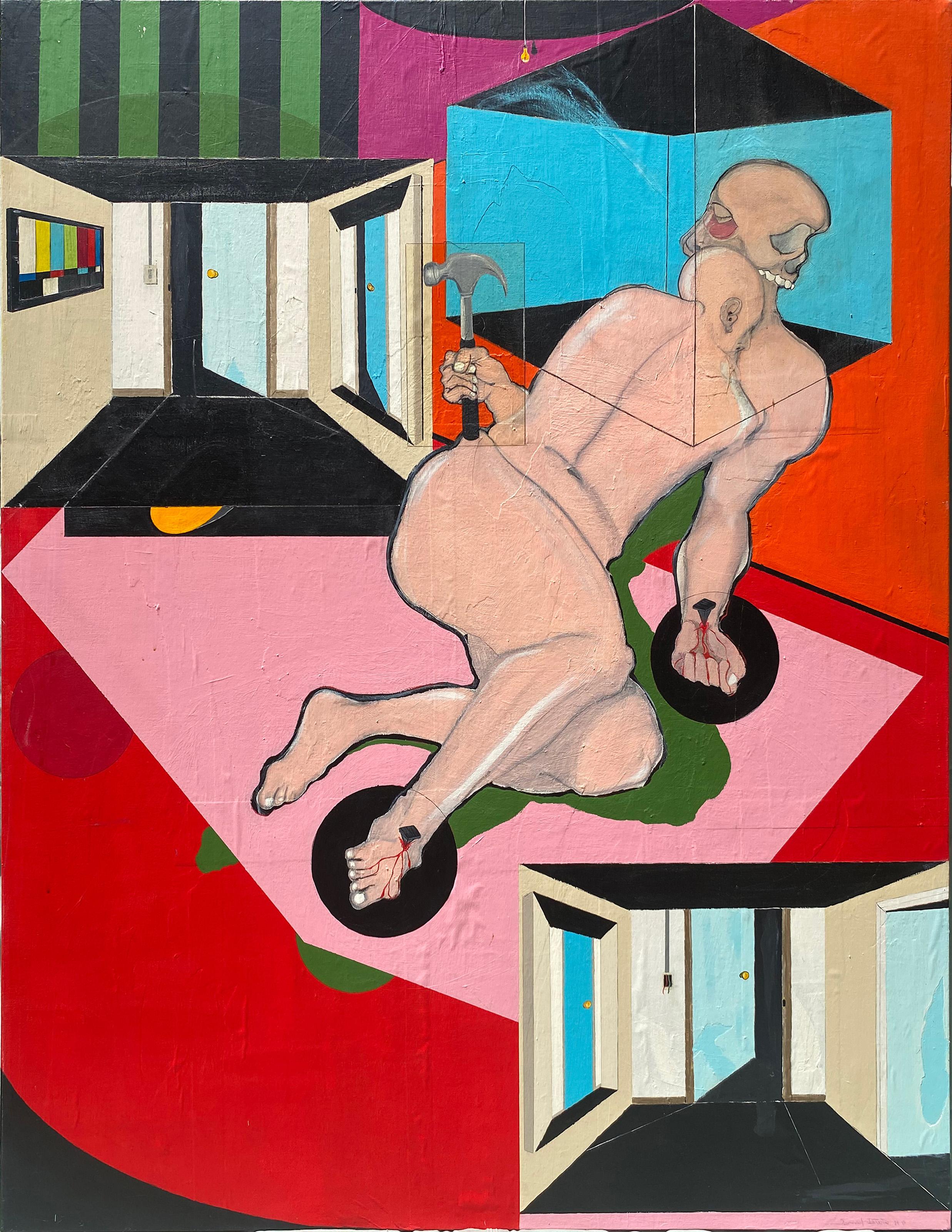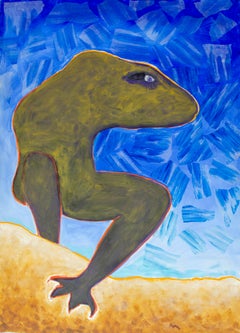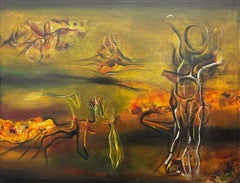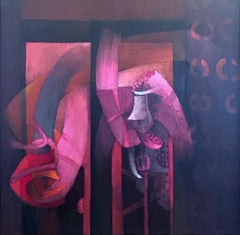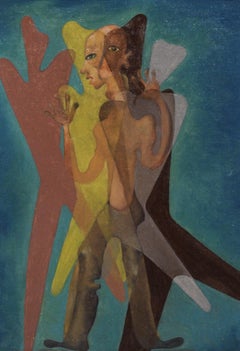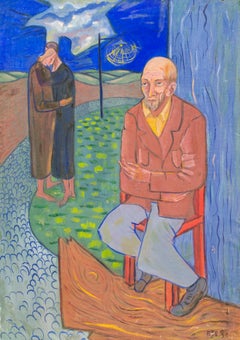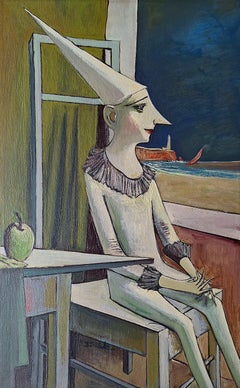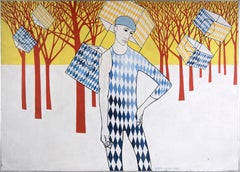Items Similar to "Deception, " Keith McIntyre, Surrealist Figure, Scottish Artist
Want more images or videos?
Request additional images or videos from the seller
1 of 10
Keith McIntyre"Deception, " Keith McIntyre, Surrealist Figure, Scottish Artist1996
1996
$4,000
£3,030.76
€3,477.56
CA$5,628.65
A$6,187.43
CHF 3,251.83
MX$75,137.94
NOK 40,565.75
SEK 38,433.20
DKK 25,953.88
About the Item
Keith McIntyre (Scottish, b. 1959)
Deception, 1996
Oil on canvas
30 x 28 inches
Signed and dated lower right
Scottish Artist Keith McIntyre was born in 1959. His work is informed by Surrealism and well renowned for crossing over a range of studio practice and performance disciplines. His interest lies in drawing, graphic fine art media and theatre. Keith has had numerous exhibitions and has been Visual Director on a range of collaborative projects including Rites (Scottish Chamber Orchestra), New Constellations for Wind, Reed and Drawing Instruments (BALTIC Centre for Contemporary Art and Sage Gateshead) and HEID (Sounds of Progress). He has won the Scottish Open Drawing competition and worked with renowned children’s writer David Almond and actor Kevin Whately to produce the Savage, an ITV documentary in partnership with Seven Stories Centre for Children’s Books.
McIntyre’s practice involves working across and with a range of media and process including drawing, painting, printmaking, photography and performance, often coming together and synthesizing in the theatre, film, musical collaboration, dance and installation. Despite the range of media employed in his work, drawing always remains at its center. In recent years McIntyre has made many large-scale drawings, allowing the paper itself to become a site for discovery. Robert Burns ‘Immortal Memory’ has been at the center of McIntyre’s research for the past decade. He has examined the content and context of this great work, discovering how its meaning translates in powerful ways in a contemporary context.
- Creator:Keith McIntyre (1959, British, Scottish)
- Creation Year:1996
- Dimensions:Height: 38 in (96.52 cm)Width: 35 in (88.9 cm)
- Medium:
- Movement & Style:
- Period:
- Condition:
- Gallery Location:New York, NY
- Reference Number:1stDibs: LU184129906152
About the Seller
5.0
Platinum Seller
Premium sellers with a 4.7+ rating and 24-hour response times
Established in 2022
1stDibs seller since 2022
122 sales on 1stDibs
Typical response time: <1 hour
- ShippingRetrieving quote...Shipping from: New York, NY
- Return Policy
Authenticity Guarantee
In the unlikely event there’s an issue with an item’s authenticity, contact us within 1 year for a full refund. DetailsMoney-Back Guarantee
If your item is not as described, is damaged in transit, or does not arrive, contact us within 7 days for a full refund. Details24-Hour Cancellation
You have a 24-hour grace period in which to reconsider your purchase, with no questions asked.Vetted Professional Sellers
Our world-class sellers must adhere to strict standards for service and quality, maintaining the integrity of our listings.Price-Match Guarantee
If you find that a seller listed the same item for a lower price elsewhere, we’ll match it.Trusted Global Delivery
Our best-in-class carrier network provides specialized shipping options worldwide, including custom delivery.More From This Seller
View All"Cronus Waiting" David Hare, Mythological Allegory Surrealist Scene
By David Hare
Located in New York, NY
David Hare
Cronus Waiting, 1990
Acrylic on linen
72 x 42 inches
“Freedom is what we want,” David Hare boldly stated in 1965, but then he added the caveat, “and what we are most afraid of.” No one could accuse David Hare of possessing such fear. Blithely unconcerned with the critics’ judgments, Hare flitted through most of the major art developments of the mid-twentieth century in the United States. He changed mediums several times; just when his fame as a sculptor had reached its apogee about 1960, he switched over to painting. Yet he remained attached to surrealism long after it had fallen out of official favor. “I can’t change what I do in order to fit what would make me popular,” he said. “Not because of moral reasons, but just because I can’t do it; I’m not interested in it.”
Hare was born in New York City in 1917; his family was both wealthy and familiar with the world of modern art. Meredith (1870-1932), his father, was a prominent corporate attorney. His mother, Elizabeth Sage Goodwin (1878-1948) was an art collector, a financial backer of the 1913 Armory Show, and a friend of artists such as Constantin Brancusi, Walt Kuhn, and Marcel Duchamp.
In the 1920s, the entire family moved to Santa Fe, New Mexico and later to Colorado Springs, in the hope that the change in altitude and climate would help to heal Meredith’s tuberculosis. In Colorado Springs, Elizabeth founded the Fountain Valley School where David attended high school after his father died in 1932. In the western United States, Hare developed a fascination for kachina dolls and other aspects of Native American culture that would become a recurring source of inspiration in his career.
After high school, Hare briefly attended Bard College (1936-37) in Annandale-on-Hudson. At a loss as to what to do next, he parlayed his mother’s contacts into opening a commercial photography studio and began dabbling in color photography, still a rarity at the time [Kodachrome was introduced in 1935]. At age 22, Hare had his first solo exhibition at Walker Gallery in New York City; his 30 color photographs included one of President Franklin Roosevelt.
As a photographer, Hare experimented with an automatist technique called “heatage” (or “melted negatives”) in which he heated the negative in order to distort the image. Hare described them as “antagonisms of matter.” The final products were usually abstractions tending towards surrealism and similar to processes used by Man Ray, Raoul Ubac, and Wolfgang Paalen.
In 1940, Hare moved to Roxbury, CT, where he fraternized with neighboring artists such as Alexander Calder and Arshile Gorky, as well as Yves Tanguy who was married to Hare’s cousin Kay Sage, and the art dealer Julian Levy. The same year, Hare received a commission from the American Museum of Natural History to document the Pueblo Indians. He traveled to Santa Fe and, for several months, he took portrait photographs of members of the Hopi, Navajo, and Zuni tribes that were published in book form in 1941.
World War II turned Hare’s life upside down. He became a conduit in the exchange of artistic and intellectual ideas between U.S. artists and the surrealist émigrés fleeing Europe. In 1942, Hare befriended Andre Breton, the principal theorist of surrealism. When Breton wanted to publish a magazine to promote the movement in the United States, he could not serve as an editor because he was a foreign national. Instead, Breton selected Hare to edit the journal, entitled VVV [shorth for “Victory, Victory, Victory”], which ran for four issues (the second and third issues were printed as a single volume) from June 1942 to February 1944. Each edition of VVV focused on “poetry, plastic arts, anthropology, sociology, (and) psychology,” and was extensively illustrated by surrealist artists including Giorgio de Chirico, Roberto Matta, and Yves Tanguy; Max Ernst and Marcel Duchamp served as editorial advisors.
At the suggestion of Jacqueline Lamba...
Category
1990s Abstract Figurative Paintings
Materials
Linen, Acrylic
"Untitled, " Sebastian Gross-Ossa, Contemporary Figurative Painting
Located in New York, NY
Sebastian Gross-Ossa (American, b. 1966)
Untitled, 2000
Oil on canvas
14 1/8 x 11 inches
Signed and dated on the reverse
Category
Early 2000s Contemporary Figurative Paintings
Materials
Oil, Canvas
$3,200 Sale Price
20% Off
"Untitled" Gerome Kamrowski, circa 1944 American Surrealist Composition
By Gerome Kamrowski
Located in New York, NY
Gerome Kamrowski
Untitled, circa 1944
Signed lower right
Oil on canvas
35 3/4 inches x 47 3/4 inches
Gerome Kamrowski was born in Warren, Minnesota, on January 19, 1914. In 1932 he...
Category
1940s Surrealist Abstract Paintings
Materials
Canvas, Oil
"El Innombrable" Fernando de Szyszlo, Red Mysticist Abstract Composition
By Fernando de Szyszlo
Located in New York, NY
Fernando de Szyszlo
El Innombrable, 1980
Titled inscribed dated verso: Orrentia 1980 "El Innombrable"
Signed lower bottom edge center "Szyszlo"
Oil on canvas
59 1/2 x 59 inches
Fernando de Szyszlo was a Peruvian painter...
Category
1980s Surrealist Abstract Paintings
Materials
Canvas, Oil
"Composition with Figure, " Irene Rice Pereira
By Irene Rice Pereira
Located in New York, NY
Irene Rice Pereira
Composition with Figure, 1951
Inscribed, signed and dated Salford/Pereira 2/51 (lr); inscribed I Rice Pereira/2669 Great Clowes St/Sa...
Category
1950s Abstract Abstract Paintings
Materials
Paper, India Ink, Casein
"Cronus Descending" David Hare, Mythological Abstract Surrealist Painting
By David Hare
Located in New York, NY
David Hare
Cronus Descending, 1971
Acrylic on linen
64 x 46 inches
“Freedom is what we want,” David Hare boldly stated in 1965, but then he added the caveat, “and what we are most ...
Category
1970s Abstract Abstract Paintings
Materials
Linen, Acrylic
You May Also Like
Latin American Modern Surreal Figure Painting, 1950's
Located in Washington, DC
Wonderful Surreal Latin American painting. Painting is oil on masonite board with original frame. Appears to be unsigned. Condition is excelle...
Category
1950s Surrealist Figurative Paintings
Materials
Masonite, Oil
$1,200 Sale Price
20% Off
Modern Surrealist Painting by Richard Ericson
By Richard Ericson
Located in New York, NY
Richard Joseph Ericson (American, 1922-2010)
Untitled, 1950
Oil on canvas
36 x 25 in.
Signed lower right: RJE '50
Richard Joseph Ericson (b. October 22, 1922-d. November 21, 2010), born in Chicago, Illinois. Son of Claire (b. 1899) and Arthur Ericson (b. 1899). His father was an accountant for a food products company and the family moved to Mount Vernon, Westchester County, New York, when he was a young child.
Ericson, a twin, first began to draw at age five and took up painting in oils at age twelve. He studied at the Art Students League in New York City in 1941, where he received an honorable mention during the annual scholarship competition held that year. During this period he worked as a commercial artist.
After America's entry in World War II Ericson enlisted in the Army in 1942, where he served as a warrant officer. He saw service in North Africa, France, and Germany. While overseas, he did many drawings of the places in which he was stationed. He eventually found himself guarding Italian prisoners of war who had been captured in Sicily and southern Italy. While performing his duties during 1943 and 1944 he found time to paint several important, large scale portraits of the prisoners who were happy to pose for him. As the war concluded he was able to visit Holland to study.
After nearly three years overseas, Ericson returned to America and traveled back to his home town of Chicago where he furthered his studies at the Art Institute of Chicago.
He married in 1948 and moved his young family to Mexico, where he attended Mexico City College. He studied art and exhibited while living there, receiving his Master of Arts degree, cum laude, in 1953.
For a time after his return to the United States he taught art in Dutchess County, New York, where he and his wife built their own house by hand. Eventually the family, which would come to include seven sons, settled in Hicksville, Long Island, New York. Ericson joined the staff of Hicksville High School as the art teacher in 1962, a position he would hold until his retirement in 1983.
As a teacher, Ericson was open to all fields and styles of art, constantly experimenting and experiencing new forms and styles. He had started printmaking in the late 1940's and continued to work in this medium for many years, producing mezzotints, etchings, and wood block prints. He also continued to paint, creating portraits, scenes in southern Dutchess County, and Long Island landscapes - for which he would become well known.
Ericson grew to love the area in which he lived, and depicted it quite often in his paintings. He became enamored with the historic village of Cold Spring Harbor...
Category
1950s Surrealist Portrait Paintings
Materials
Canvas, Oil
Alex. Figurative Oil Painting, Surrealist, European art
By Iwan Kulik
Located in Warsaw, PL
Figurative oil on canvas painting by Iwan Kulik. Painting is in warm tones, main colors are brown, yellow nad green. Iwan Kulik has created his own characteristical style that is rec...
Category
20th Century Contemporary Figurative Paintings
Materials
Canvas, Oil
Large Scale Surrealist Portrait in Acrylic on Board
Located in Soquel, CA
Large Scale Surrealist Portrait in Acrylic on Board
Bold surrealist portrait by Robert William Hinds (American, b. 1926). This piece has a dream-like quality, with the subject stand...
Category
1990s Contemporary Figurative Paintings
Materials
Acrylic, Masonite, Stretcher Bars
Logic is the man's weakest defence - XX century, Colourful figurative painting
By Adam Niemczyc 1
Located in Warsaw, PL
ADAM NIEMCZYC (born in 1914) Painter, graphic artist, poet, novelist. He practiced easel, mural painting and book illustration. Since 1958 he participated in numerous exhibitions in ...
Category
1980s Other Art Style Figurative Paintings
Materials
Gouache, Cardboard, Tempera
El Cuadvado, Surrealist Oil and Acrylic Painting by Samuel Iztueta
Located in Long Island City, NY
Samuel Iztueta, American - El Cuadvado, Year: 2013, Medium: Oil and Acrylic on Canvas, signed and titled with writing verso, Size: 60 x 48 in. (152.4 x 121.92 cm)
Category
2010s Surrealist Figurative Paintings
Materials
Oil, Acrylic
